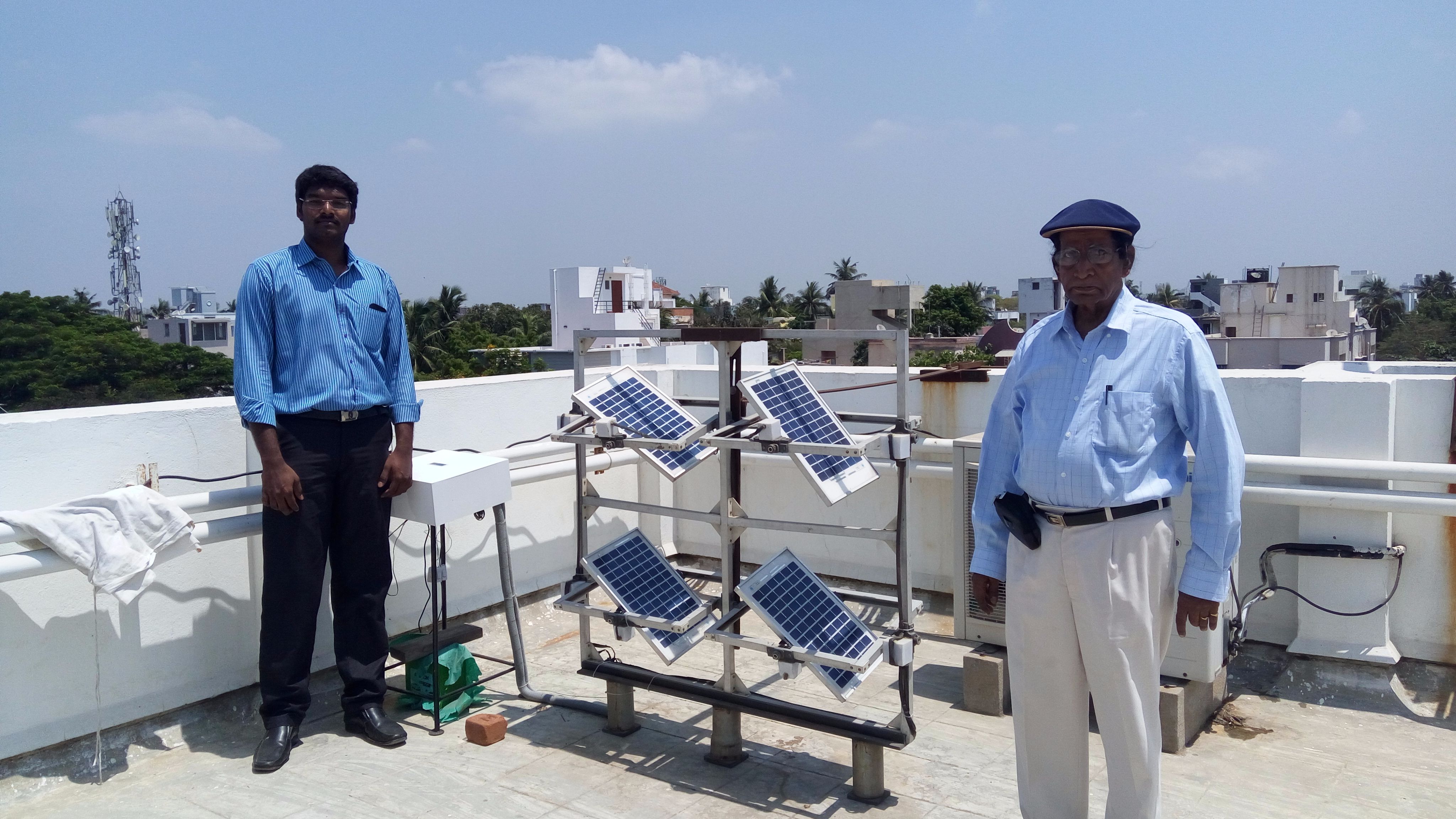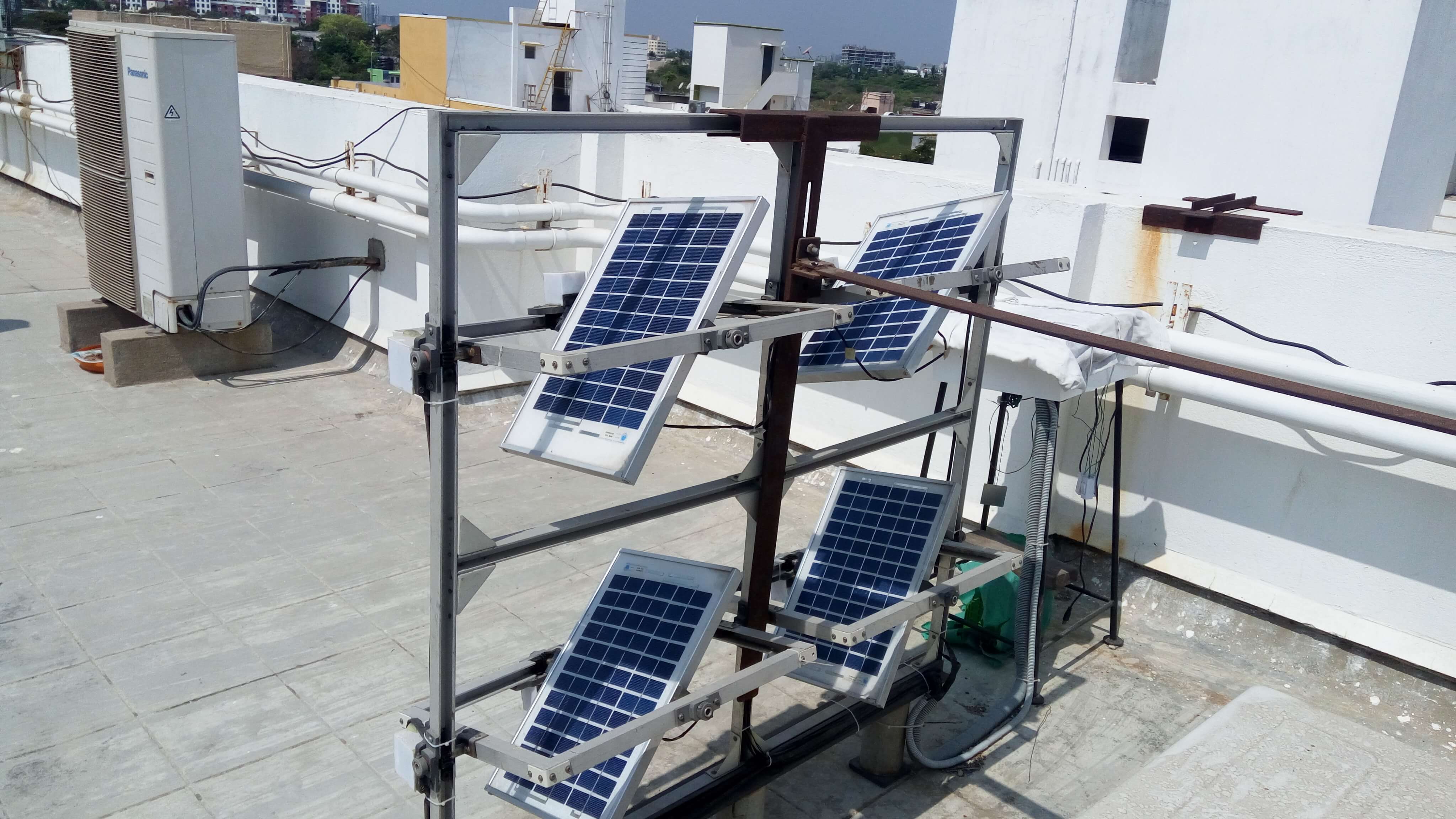This blog post is written with the intention of highlighting the importance of solar innovations in a fast-growing solar industry and specific aspects regarding the challenges and constraints faced in implementing them.
The particular case study of focus here is a vertically stacked solar array prototype developed by Mr T. R. Jayaraman. It is referred to as ‘Madil Raja’ due to its’ suitability to be easily placed over a parapet. The prototype is displayed in the figure below.
Figure 1: Mr. T. R. Jayaraman (Right) and Mr. K. Gopinath who assisted in programming and electronics, with the prototype
The model has been developed over a span of 4 years. Over the past one year he had the help of Mr. Gopinath on electronics and programming and installation of micro controller with allied parts. He also acknowledges help from workshop for fabrication and CAD drawing, and seeks help from Shilaja Srinivasan, his daughter, on varied matters.
This model Madil Raja (MR for short) is only a building block and the invention is called “Oli Min Palhai”. The main scope is to scale up this MR into many arrays stacked vertically and also with stacks in rows. While thus stacked in arrays, MR will be known as MM. The invention is focused at creating an equipment that can be used as a roof top equipment. Such possibility of rooftops would allow peoples’ participation in solving the power problem just like how rain water harvesting gained prominence due to the ground water problem. The present flat-bed types do not render themselves suitable for small areas in domestic roof tops.
A typical flat-bed system occupies about 9 sq. m floor area for 1 KW. While MR will do this in about 70% of this area, the main saving will come when building up arrays. For example, a 500 KW conventional slant installation would need 0.75 acres as opposed to the current requirement of 2.5 acres. This becomes a precious advantage while considering that we would be needing a large number of such medium sized power stations.
Now, let’s delve into a comprehensive description of the model.
Firstly, what problem does this model solve?
With a rising number of solar installations, the space required for solar plants will turn out to be a major constraint in the near future. The vertical design of this prototype has a huge scope of being a space-saver.
A typical flat-bed system can occupy around 100 square feet per kW. But Madil Raja will take up 50-60 square feet of area per kW, which means a 40-50% reduction in area.
Design of the system
As shown above, the model comprises two rows of panels arranged one above the other. As this is a basic model constructed for initial trial, the output is sufficient only for charging a battery. As this has been found technically successful, attempt will now be for larger models and for building arrays of this MR. Presently load is tried in the form of LED cluster.
A brief description of the system has been given below.
| Parameter | Value |
| No. of Panels | 4 |
| Wattage (Wp) | 10 |
| Panel Manufacturer | Maharishi Solar |
| Purpose | Roof top equipment scalable as large arrays too. |
| Special Features | Dual-axis trackers |
The design employs dual-axis trackers which uses a stepper motor for the rotation. There are 8 stepper motors. 4 are for East to West movement of inner frame and 4 are for seasonal tracking through the outer frame. The azimuth stepper motors make 72 turns per day. Use of stepper motors give accuracy of movement.
The stepper motors are controlled by a time-algorithm which has been developed by K. Gopinath (electrical graduate who has been providing assistance to Mr Jayaraman for a year).
The stepper motors are driven by a micro controller where the programming has been done by Shri Gopinath on the chronology table given to him. Shri gopinath has been of great assistance to Shri Jayaraman.
There is a control box/meter where the electrical wires and drivers for the motors are placed.
The inventor is planning to implement an A-shaped design which will further reduce the shading on the panels.
Challenges
Of course, by the nature of any new idea, its presents itself with a set of challenges starting from design to the implementation. Let’s take a look at some challenges encountered by the inventor.
- Shading Problems
Popular understanding states that shading can significantly reduce the output in this case. But the prototype has been tested and improved to accommodate this issue.
Figure 2: Shading on the prototype
Take a look at how the top row of panels cause shading on the lower row of panels.
|
Although there is the problem of shading, according to the inventor, tests and experiments over a period of time shows that shading does not reduce the power output significantly. Shading was found to reduce the voltage level by just 2 volts in the case of the lower panels. In fact, the shadow of the top row of panels falling on the bottom ones, reduces the temperature of the bottom panels (50°C – 42°C). The reduced temperature is optimal for solar generation and was observed to improve the output of the bottom panels. |
- Lack of support for implementation
Despite applying for securing the patent three years back at the patent office, Mr Jayaraman has not received it until now. The officials cited a lack of staff for the problem. This clearly highlights the lack of supporting in India for getting new ideas to fruition.
- Hurdles in availing funding
The department of industries refused to provide funding for the project and even cited the age of the inventor as a reason for it.
Ideas for Project Realization
- One possible market for such a product is electric scooters. The batteries can be charged by setting up remote stations with vertically stacked solar panels which occupies less space. Moreover, the batteries can be recharged on a rotation basis thereby ensuring that there is constant supply of charged batteries.
- Rural electrification programmes, which are being implemented at a fast pace across India these days, is one segment where solar panels are of much interest. In such a scenario, MR solar panels which offer a higher output generation at a reduced area can gain prominence.
Solar Mango sincerely hopes that Madil Raja receives the much-needed market visibility it needs and wishes Mr T. R. Jayaraman all the best!
 Skip to content
Skip to content


